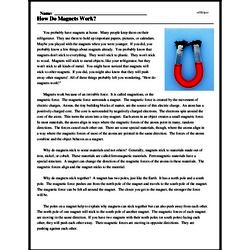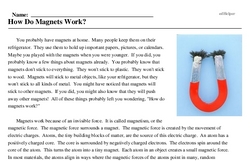How Do Magnets Work?
You probably have magnets at home. Many people keep them on their refrigerator. They use them to hold up important papers, pictures, or calendars. Maybe you played with the magnets when you were younger. If you did, you probably know a few things about magnets already. You probably know that magnets don't stick to everything. They won't stick to plastic. They won't stick to wood. Magnets will stick to metal objects, like your refrigerator, but they won't stick to all kinds of metal. You might have noticed that magnets will stick to other magnets. If you did, you might also know that they will push away other magnets! All of these things probably left you wondering, "How do magnets work?"
Magnets work because of an invisible force. It is called magnetism, or the magnetic force. The magnetic force surrounds a magnet. The magnetic force is created by the movement of electric charges. Atoms, the tiny building blocks of matter, are the source of this electric charge. An atom has a positively charged core. The core is surrounded by negatively charged electrons. The electrons spin around the core of the atom. This turns the atom into a tiny magnet. Each atom in an object creates a small magnetic force. In most materials, the atoms align in ways where the magnetic forces of the atoms point in many, random directions. The forces cancel each other out. There are some special materials, though, where the atoms align in a way where the magnetic forces of most of the atoms are pointed in the same direction. The forces of the atoms combine and the object behaves as a magnet.
Why do magnets stick to some materials and not others? Generally, magnets stick to materials made out of iron, nickel, or cobalt. These materials are called ferromagnetic materials. Ferromagnetic materials have a special structure. A magnet can change the direction of the magnetic forces of the atoms in these materials. The magnetic forces align and the magnet sticks to the material.




